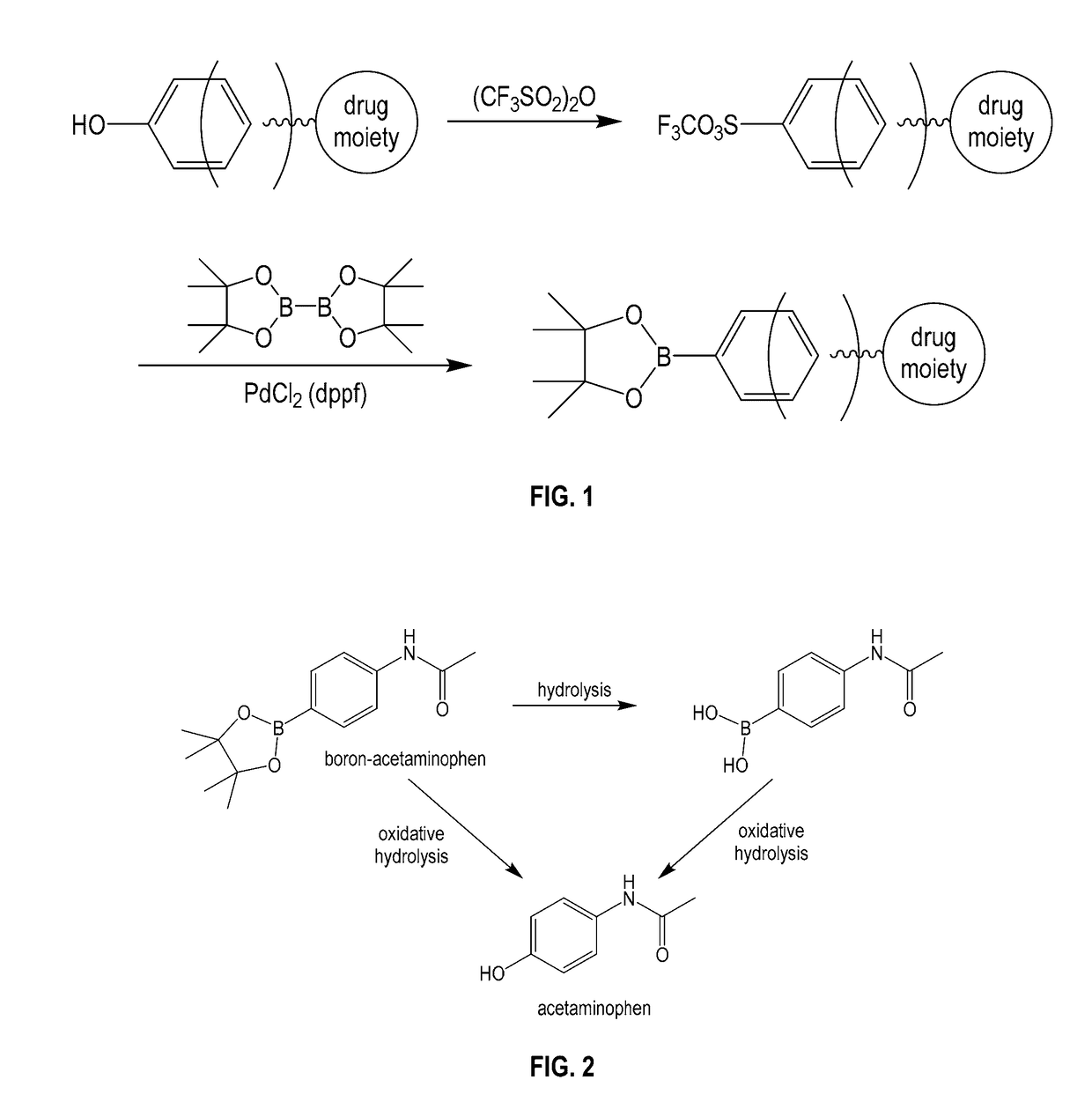Boron-based prodrug strategy for increased bioavailability and lower-dosage requirements for drug molecules containing at least one phenol (or aromatic hydroxyl) group
a boron-based, drug-molecule technology, applied in the direction of group 3/13 element organic compounds, antibacterial agents, immunological disorders, etc., can solve the problems of lungs or eyes, serious blood clots in legs, etc., to improve bioavailability, prolong the retention period of patients, and increase the plasma concentration of active drug forms
- Summary
- Abstract
- Description
- Claims
- Application Information
AI Technical Summary
Benefits of technology
Problems solved by technology
Method used
Image
Examples
example 1
[0066]Pinacolyl Boronate Ester Prodrug of Acetaminophen (FIGS. 2 & 3)
[0067]To determine if boron-acetaminophen derivatives have enhanced bioavailability in vivo, pharmacokinetic studies were performed in mice where boron-acetaminophen was orally administered to mice as a single dose at 5 mg / kg and the drug concentrations in mouse blood were monitored over a period of 24 hours.
[0068]The boron-containing acetaminophen prodrug showed 5-10 fold increases in the plasma concentrations of acetaminophen, thus reducing the therapeutically effective dose requirement to a level that is much less likely to cause accidental overdose.
[0069]The results of these studies are presented in FIG. 3 and demonstrate a significant increase in plasma concentration (bioavailability) of acetaminophen in mice administered boron-acetaminophen compared to mice administered an equal dose of acetaminophen.
example 2
[0070]Pinacolyl Boronate Ester Prodrug of Fulvestrant (FIGS. 4-6)
[0071]Step 1: To a solution of N-2 (0.80 g) and pyridine (0.24 mL) in DCM (15 mL) was added trifluoromethanesulfonic acid anhydride (0.2 mL) dropwise at −10° C., and the resulting mixture was stirred until the reaction was finished. The reaction was quenched with satd. sodium carbonate solution and extracted with ethyl acetate. The combined organic layer was dried over MgSO4 and concentrated. The crude was purified by flash column to afford liquid product (0.70 g).
[0072]Step 2: The mixture of the triflate of N-2 (0.76 g), bis(pinacolato)diboron (0.378 g), potassium acetate (0.268 g, 9.72 mmol), Pd(OAc)2 (30 mg) and tricyclohexylphosphine (60 mg) in acetonitrile (20 mL) was stirred at 80° C. under N2 overnight. The solvent was removed under vacuum and the crude was purified by flash chromatography to afford product (0.50 g).
[0073]Step 3: To a solution of the pinacolyl boronate ester of N-2 (0.5 g) in MeOH-THF (1:1, 4 mL...
example 3
[0078]Pinacolyl Boronate Ester Prodrug of Raloxifene (FIGS. 7 & 8)
[0079]Step 1: A solution of trifluoromethanesulfonic anhydride (0.84 g, 0.48 mL, 3.0 mmol) in CH2Cl2 (5.0 mL) was added dropwise to a solution of pyridine (0.25 mL, 3.0 mmol) and raloxifene (0.47 g, 1 mmol) in anhydrous CH2Cl2 (10 mL) at 0° C. After complete addition, the mixture was warmed to room temperature and allowed to stir for 1 hour. The mixture was then diluted with Et2O, quenched with 10% aq HCl and washed successively with sat. NaHCO3 solution and brine. After drying over MgSO4, the solvent was removed under reduced pressure and the residue was purified by flash column chromatography to give the ditriflates (0.16 g). 1H-NMR (300 MHz, CD3Cl): 7.86-7.83 (m, 2H), 7.68 (d, J=8.4 Hz, 2H), 7.48 (d, J=8.4 Hz, 2H), 7.33 (dd, J=8.7 and 1.5 Hz, 1H), 7.16 (d, J=8.7 Hz, 2H), 6.77 (d, J=8.4 Hz, 2H), 4.34 (t, J=3.3 Hz, 2H), 3.36 (t, J=3.3 Hz, 2H), 3.10 (m, 4H), 1.92 (m, 4H), 1.62 (m, 2H). 13C-NMR (75 MHz, CD3Cl): 191.4, ...
PUM
 Login to View More
Login to View More Abstract
Description
Claims
Application Information
 Login to View More
Login to View More - R&D
- Intellectual Property
- Life Sciences
- Materials
- Tech Scout
- Unparalleled Data Quality
- Higher Quality Content
- 60% Fewer Hallucinations
Browse by: Latest US Patents, China's latest patents, Technical Efficacy Thesaurus, Application Domain, Technology Topic, Popular Technical Reports.
© 2025 PatSnap. All rights reserved.Legal|Privacy policy|Modern Slavery Act Transparency Statement|Sitemap|About US| Contact US: help@patsnap.com



